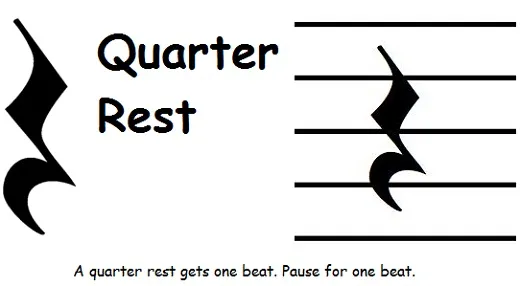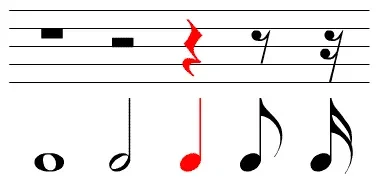In the world of music notation, symbols are essential tools that communicate what performers must do. While most people quickly recognize notes and their values, rests—symbols that indicate silence—are just as important. Among them, the quarter rest holds a particularly vital role. It signifies a single beat of silence, often acting as a rhythmic placeholder in music. For musicians and students alike, mastering rest symbols is crucial for proper timing, phrasing, and interpretation of musical pieces.
Understanding when not to play is as important as knowing what to play. The quarter rest helps define the shape and flow of rhythm, contributing to the clarity and emotional impact of music. Whether you’re a beginner just learning the basics of rhythm or an advanced performer reading complex scores, knowing how to recognize, interpret, and use the quarter rest can significantly improve your musical accuracy and expression.
What is the Quarter Rest Symbol?
The quarter rest is a symbol that tells the performer to remain silent for the duration of one quarter note. Visually, it is often represented as a small, stylized squiggle that resembles a backward “Z” stacked on top of a “C” or as a vertical squiggly line, depending on the notational style. In printed scores, the design is standardized, but slight variations can occur between fonts and hand-written music.

The quarter rest is part of a family of rest symbols, each corresponding to a specific note value. These include the whole rest (four beats), half rest (two beats), eighth rest (half a beat), and so on. Among them, the quarter rest is one of the most frequently used, especially in music written in common time (4/4). Understanding how to visually identify it and distinguish it from similar rests—like the eighth rest, which is more angular and shorter—is essential for accurate music reading.
>>Learn more about other music rest symbols
Duration and Value of Quarter Rest
The quarter rest represents one beat of silence in music written in 4/4 time, the most common time signature. It aligns directly with the quarter note, which also takes up one beat—but while the quarter note signifies sound, the quarter rest commands silence. This silence is just as rhythmically significant as a note. A performer must count the beat and remain still during the quarter rest, maintaining the tempo and feel of the music.

Importantly, the duration of a quarter rest changes relative to the time signature. In 2/4 or 3/4 time, it still takes up one full beat. However, in compound meters like 6/8, the quarter rest no longer lines up with the main beats, making rhythm interpretation slightly more complex. Regardless of time signature, its duration remains equal to one quarter note’s length within that specific context.
Musicians must practice internalizing the quarter rest’s value and resisting the urge to rush or overlook these silences during performance.
Visual Examples of Quarter Rest
To truly understand the quarter rest, seeing it in context is incredibly helpful. In a standard musical staff, a quarter rest usually appears centered within a measure, occupying one beat. For example, in a 4/4 time signature, you might see a sequence such as: quarter note – quarter rest – quarter note – quarter rest. This structure allows you to hear the rhythm as an alternating pattern of sound and silence.
If your website allows it, you can enhance this learning experience with interactive visual tools. Showing the rest on a five-line staff and pairing it with audio examples helps learners connect the visual symbol to its actual timing. Try including short musical excerpts that demonstrate how quarter rests are placed among different note values and how they affect the phrasing and rhythm of a melody.
Learning to visually recognize the rest in sheet music and anticipate the silence it demands is key to reading and performing accurately.
Common Uses in Music
Quarter rests appear in almost every style of music—from classical and jazz to rock, pop, and beyond. In many rhythmic patterns, especially those built around syncopation or call-and-response structures, the quarter rest plays a critical role. For example, in jazz drumming, a quarter rest may mark the “space” in a groove, creating tension or anticipation. In classical music, it often supports phrasing or allows for breathing moments in wind and vocal pieces.
Even in ensemble settings like orchestras or bands, quarter rests help musicians stay synchronized. They indicate precise places where players must pause, allowing other sections to be heard clearly. In solo compositions, composers may use quarter rests to shape dramatic tension, musical contrast, or emotional nuance.
Recognizing how composers use quarter rests artistically—as part of the overall musical expression—can help musicians interpret pieces more thoughtfully and sensitively.
How to Read and Count Quarter Rests
Reading and counting quarter rests is a foundational skill in music literacy. In 4/4 time, where each measure contains four beats, a quarter rest takes up one full beat. If you see a quarter rest on beat 2, you’d count: “1 (note), 2 (rest), 3 (note), 4 (note).” You do not skip the rest or play through it—timing must remain precise.
One effective method for counting is to tap your foot steadily while silently acknowledging the rest beat. Saying the beat numbers out loud during practice is another helpful technique. For example, during a rest, say “(rest)” or clap silence to maintain awareness without playing.
In more complex time signatures like 5/4 or 7/8, you’ll need to pay closer attention to how rests divide uneven measures. Consistent rhythm practice, such as with a metronome, helps internalize the duration of rests and prevents accidental rushing.
Developing accuracy in counting rests is as important as playing notes correctly—it builds your rhythmic confidence.
Writing the Quarter Rest
Writing the quarter rest by hand can be a challenge for beginners, as it’s one of the more stylized rest symbols. Traditionally, it is drawn as a jagged, vertical squiggle with four strokes: a small downward stroke, then a curved loop upward, followed by another downward stroke, and ending in a small curl at the bottom. It should be vertically centered within the staff and take up roughly the same horizontal space as a note.
Practice is key. Start by copying printed examples, then try to replicate the shape freehand until it becomes second nature. Accuracy and clarity are important, especially when writing for others or submitting work.
In digital music notation software like MuseScore, Sibelius, or Finale, adding a quarter rest is simple. Most programs assign it a shortcut (such as pressing “5” in MuseScore). These tools automatically place the rest in the correct position and spacing, making notation more efficient and precise.
Understanding how to write the symbol yourself deepens your grasp of musical structure and rhythm.
Quarter Rest Symbol in Digital Formats
As more musicians turn to digital platforms for composing, teaching, and sharing music, it’s helpful to know how to represent the quarter rest symbol digitally. While rests are normally inserted using music notation software, you may sometimes need to represent the quarter rest in text format, such as on a website or in a document.
In Unicode, the quarter rest symbol is represented as 𝄽 (U+1D13D), but support across fonts and browsers may vary. Instead, most people use music notation fonts like Bravura, Maestro, or Opus when displaying symbols accurately. These fonts allow you to insert a quarter rest that matches professional engraving standards.
If you’re using HTML, it’s best to include the symbol as part of an image or embedded font from a music typesetting tool. For educational websites like yours, combining visual clarity with alt text descriptions improves both accessibility and search engine optimization (SEO).
Being able to type or display music symbols digitally makes your content more versatile and professional.
Common Mistakes to Avoid
While the quarter rest seems straightforward, beginners often make mistakes that affect rhythm and interpretation. One common error is confusing it with the eighth rest, which looks somewhat similar but represents only half a beat. Playing during a rest—whether by mistake or miscount—is another frequent issue. Silence must be honored with the same discipline as notes.
Another pitfall is overlooking rests entirely, especially in fast passages or when sight-reading. This can disrupt the timing of an entire ensemble, leading to coordination issues. Additionally, some learners fail to practice rests the way they practice notes. This results in uneven phrasing or an inability to “feel” the rhythm internally during pauses.
Musicians should also avoid rushing through rests, especially in syncopated rhythms. Counting out loud or using a metronome during practice helps internalize the beat and improves confidence. Teachers often recommend “shadow playing” (moving silently through the motions) to build comfort with rests.
The quarter rest symbol is an essential part of music notation, representing one beat of silence in standard time. While it may appear simple, its role in shaping rhythm, dynamics, and musical expression is profound. Recognizing, counting, and respecting quarter rests is vital for performers across all skill levels and genres.
Whether you’re reading your first piece of sheet music or writing a complex composition, understanding the quarter rest ensures your timing is precise and your interpretation is true to the composer’s intent. By studying its appearance, value, practical uses, and digital representation, you’ll deepen your overall music literacy.
Remember: in music, silence is not the absence of sound—it’s an integral part of the rhythm. The quarter rest reminds us that sometimes, what we don’t play is just as important as what we do.

Evan Carter is an American music educator. With a background in Musicology and over 10 years of experience, he specializes in music theory and notation. Evan creates clear, accessible content to help learners of all levels understand the language of music through symbols, structure, and sound.

